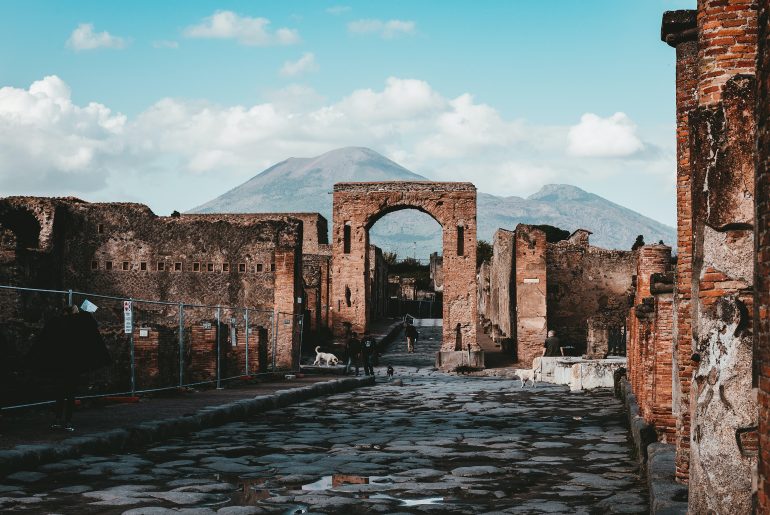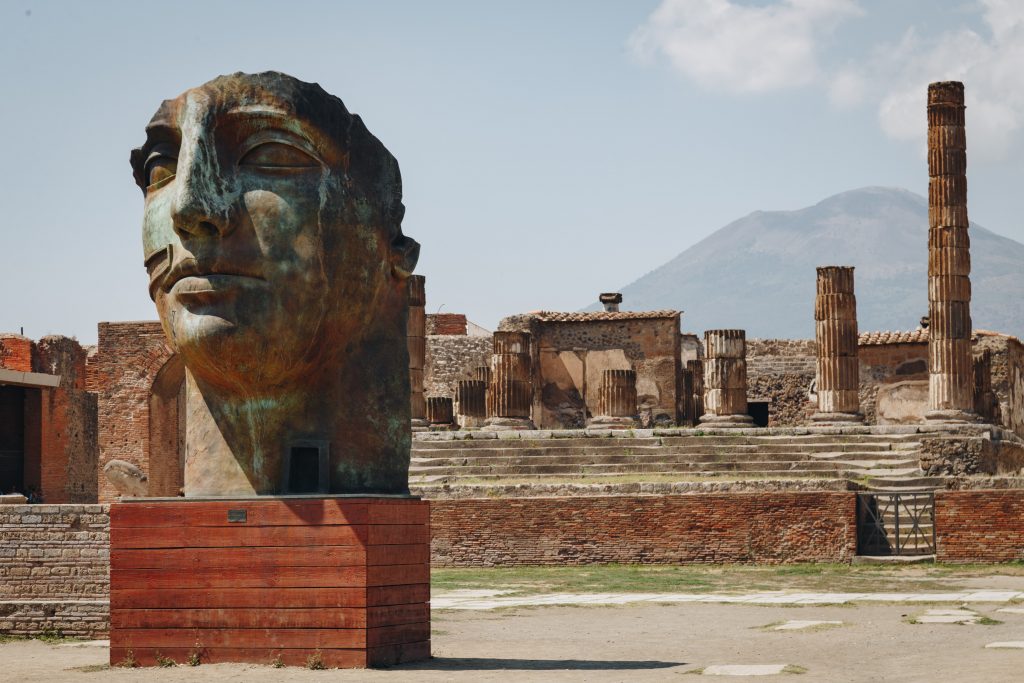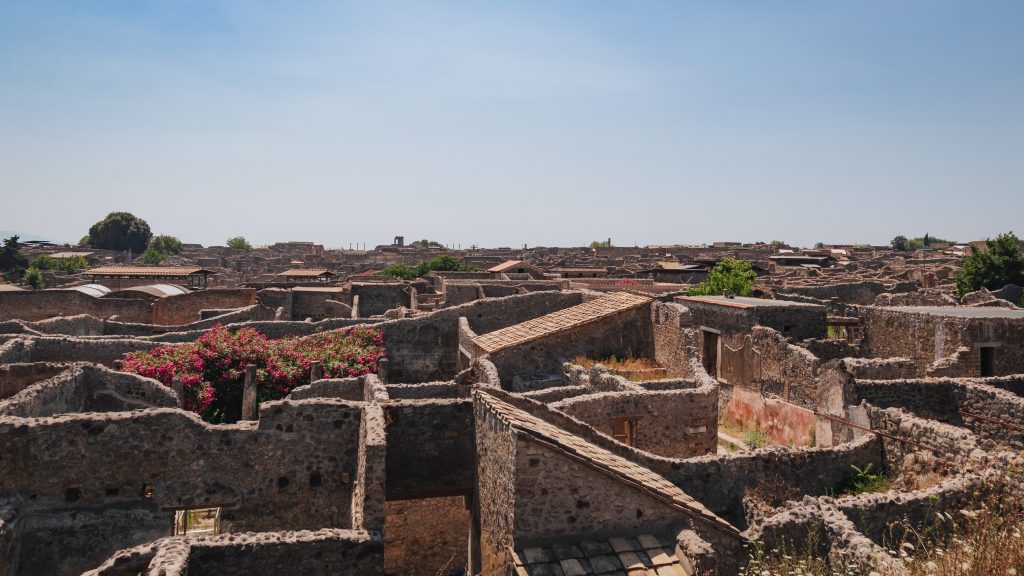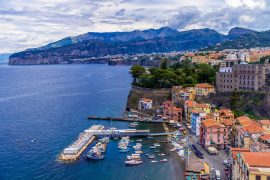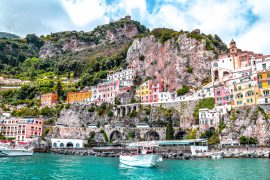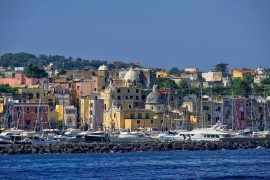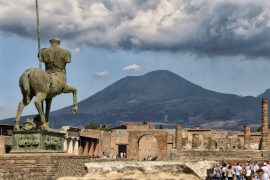Pompeii is a remarkable monument, listed as a UNESCO World Heritage Site. The complex of ancient ruins of Pompeii with a total area of 44 hectares (the largest archaeological site in the world) is located near the modern city of the same name. It is located in the province of Naples, w region Campania on the Gulf of Naples, on the Apennine Peninsula.
Although there are quite a few monuments from ancient times in the world, Pompeii fascinates tourists much more than others. And this is all due to a catastrophe that put the city and some of its inhabitants in a "time capsule" for centuries. Volcanic eruption Vesuvius in 79 AD transformed the prosperous metropolis of the time into a mysterious necropolis, buried in a torrent of pyroclastic material and hot ash. It is estimated that there were about 2,000 residents frozen for centuries. These were those who hid in their homes. The rest managed to escape, sensing the worst. The excavation of Pompeii began in 1748 and continues to this day. The result of the work is a huge ruins of an ancient city, towards which it is impossible to pass indifferently. There is something terrifying and fascinating at the same time in the history of Pompeii. A trip to this place is a must when visiting Naples.
History of Pompeii
The history of Pompeii begins in the 8th century BC, when the city was founded by the Oscars. Later the settlement fell into Greek, then Etruscan and then Samnite hands. And it was the Samnite rule that made Pompeii an important port on the Tyrrhenian Sea. The 4th century BC brought new rule. The city came under Roman influence, becoming a colony of the Empire in 80 AD. Under Roman rule, port trade and agriculture, based on vine and olive cultivation, flourished, contributing to not only economic but also cultural development of the city. On February 5, 62 Pompeii was hit by a powerful earthquake that destroyed many architectural structures. After the event, the city was rebuilt with great vigor. At the time, Pompeii was considered one of the most beautiful urban centers in the entire Roman Empire. Wealthy patricians erected their stately mansions here, where they enjoyed relaxing. The residents of the time also used the baths, admired the gladiatorial displays and worshipped the deities in their stately temples. The Pompeian forum was also bustling with life.
Vesuvius eruption
On August 24, 79 AD, a huge ancient tragedy occurred. Mount Vesuvius, towering over the city, unexpectedly erupted. The explosion was preceded by a plume of smoke rising from the crater. It turned into a column of fire, spitting dangerous "lapis lazuli" dust, composed of shards of glowing rocks and pumice. The air temperature during the eruption of Vesuvius could reach as high as 600 degrees Celsius! Many surprised residents of Pompeii were buried alive under the rain of volcanic ash. Some managed to escape. Lapis lazuli and hot magma annihilated the mighty city, hiding it for many centuries.
The discovery of the ruins of Pompeii
In 1599, during the construction of the canal, Italian architect Domenico Fontana made an extraordinary discovery - he noticed the remains of an ancient city. The find began to be unearthed on April 6, 1748. The volcanic ash perfectly preserved the buildings and everyday objects, preserving the city in the same condition as on the day of the eruption. The bodies of the victims were not preserved, but in the places where the ash covered them blank spaces were created, looking like molds of plaster casts, accurately showing their positions. This allows us to imagine what they looked like at the time of the disaster. Some died in solitude, others in the embrace of loved ones, while others were buried by lapis lazuli while trying to escape. An interesting fact about the modern history of Pompeii is that in 1971 the iconic band Pink Floyd played a concert there in the ruins of the ancient amphitheater. This event was recorded as the film "Pink Floyd: Live at Pompeii."
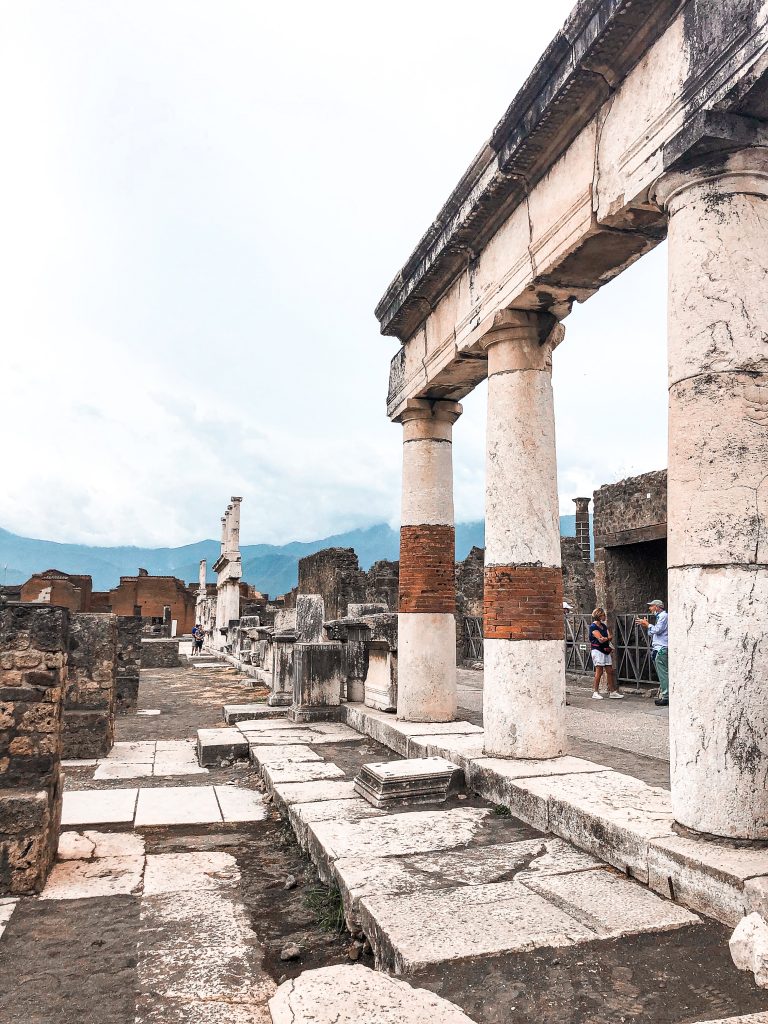
In 1997 the archaeological site of Pompeii was declared a UNESCO World Heritage Site and in 2014 the historical drama "Pompeii" was filmed, directed by Paul W. S. Anderson. The film shows the story of a gladiator, set against the backdrop of a natural disaster, allowing us to imagine the day Vesuvius erupted and the city was annihilated.
How to get to Pompeii?
The most convenient way to get to Pompeii is from Naples. There are two options - your own car or public transportation. Directly at the archaeological site there are several parking lots, charged at 5 EUR per day. Driving time from the center of Naples is about 30 minutes.
If you do not have a car, nothing is lost. Naples and its surroundings are very well connected. To reach the ruins of ancient Pompeii, it is best to take the train Circumvesuviana. In Naples, we set off from the main train station, located at the Piazza Garibaldi, or from the earlier Porta Nolana station. Trains of the line Naples - Sorrentowhich we will be traveling depart every half hour. Get off at the stop Pompei Scavi - Villa dei Misteri. Note that Pompeii station is the center of the modern city of the same name, not the ruins of interest. As soon as we leave the train car, one of the entrances to the ancient city will appear before our eyes. Detailed timetable and current ticket price list can be found here.
Price list and opening hours
Currently (calendar in effect from November 1 to March 31, 2022), the complex of the ancient city of Pompeii is open daily from 9:00 a.m. to 5:00 p.m. (last entry 3:30 p.m.). During the season, i.e. from April 1 to October 31, 2022, the opening hours are extended daily from 9:00 am to 7:00 pm (last entry 5:30 pm). During these hours, all attractions located in the open space can be visited. Closed buildings, e.g., some villas with wall paintings, are open from 9:15 a.m. to 4:20 p.m. (last entrance at 4 p.m.). Detailed opening hours of each building are available on the official website of the archaeological site of Pompeii -. Open buildings - Pompeii Sites.
Advance tickets can be purchased online (Buy tickets - Pompeii Sites) or at the ticket office before entering the city. It is worth watching out for people who accost tourists on the street, wanting to sell entrance fees, or stalls near parking lots. If you do not want to overpay for entrance fees, use only official ticket offices. Current ticket price list can be found here. Currently, an adult ticket costs €16, a discounted ticket (for 18 to 24 year olds) costs €2 and everyone under 18 can visit Pompeii for free.
Tour of Pompeii
Pompeii is the third most visited tourist destination in Italy. It is estimated that more than 2.5 million people visit it annually. Considering such a high tourist traffic and epidemiological situation, it is worth buying tickets in advance. We can visit Pompeii on our own, or for a surcharge (€10) use the services of an English-speaking guide, who will guide us through the attractions. Choosing to explore the archaeological complex on your own, it is worth remembering that it covers a huge area (44 hectares), so a map can be very helpful (downloadable on the official website or available free of charge in print, along with brochures describing each attraction at the tourist information desk, at the ticket offices). It is also possible to rent on site audio guide (€8 per person) or download a paid app on your phone Discover Pompeii.
The ruins of the ancient city contain so many attractions that to visit them you need a minimum 3 - 4 hours. However, lovers of ancient Roman culture should reserve a full day.
It is advisable to start visiting as early as in the morning, avoiding weekends if possible. This gives us a chance to avoid crowds. Tourists entering Pompeii are required to follow the rules and regulations. Its most important points stipulate, among other things, that one person can bring one small backpack or bag into the complex. Other packages will have to be left in the free baggage room. Throughout the site it is mandatory to no smoking, and dining can only be done in specially designated areas. You can bring your own provisions or use the only restaurant available in the entire complex. Drinkable water is available in small fountains along the main alleys.
People with disabilities can also visit ancient Pompeii. The management of the complex has designated special prepared paths for this purpose, which can also be used by parents with children in strollers.
Many of the relics found during the archaeological excavations ended up in the National Archaeological Museum in Naples. A visit here will therefore complement a visit to Pompeii. Another noteworthy attraction in the area is also Herculaneum, a much smaller ancient city that shared the fate of Pompeii.
Those using public transportation who wish to see the two cities unearthed from under the solidified volcanic ash and the Archaeological Museum should consider purchasing a card Campania ArteCard. For the price of 32€ for adults or 25€ for students and pupils, you can enjoy unlimited public transportation and visit any 2 attractions (entrance to the others at a discount).
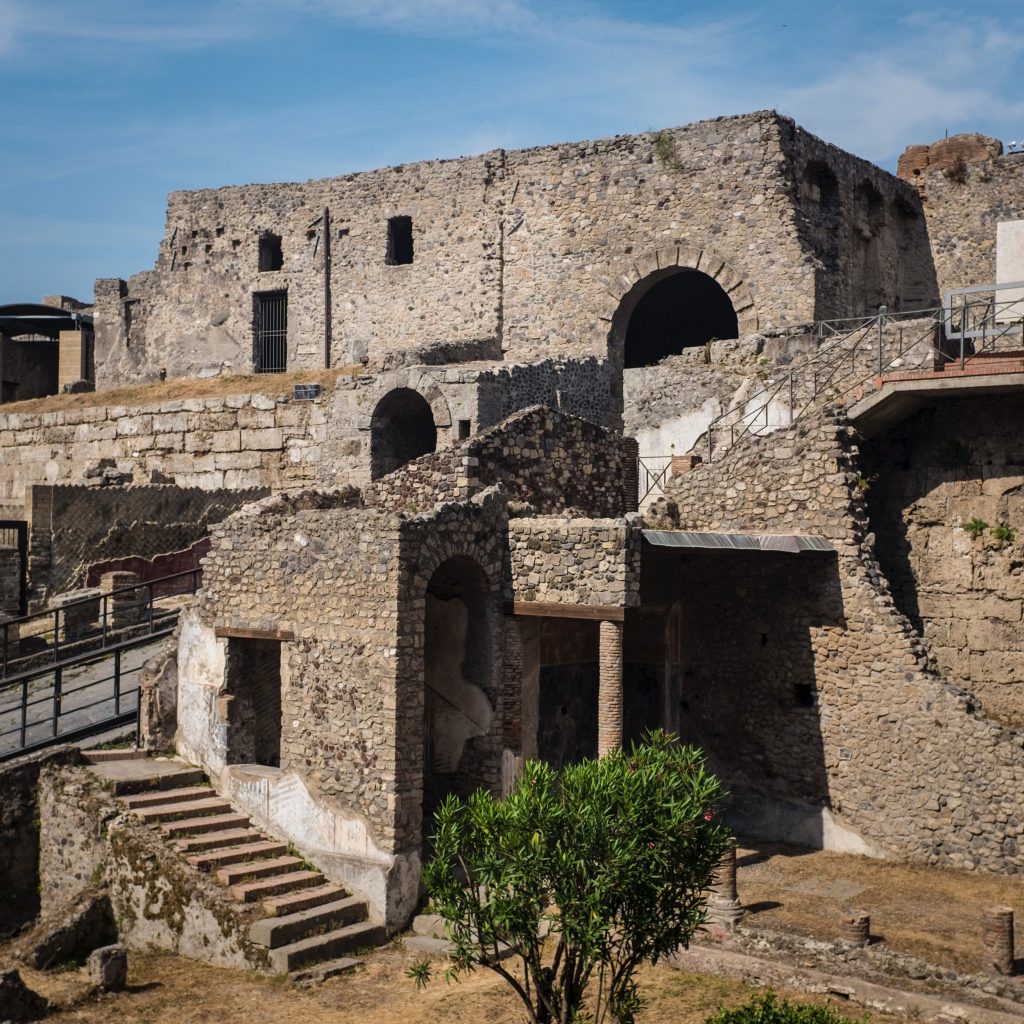
Attractions - what to see while in Pompeii?
The monuments unearthed in Pompeii allow us to imagine what this ancient city looked like before the great catastrophe. Here are its most interesting attractions that have survived for hundreds of years, carefully preserved with material from the volcano.
Foro Civile di Pompei (Forum)
The first attraction of the Pompeian ruins is their forum, a place equivalent to modern markets. The square, measuring 38 by 157 meters, was crowded every day by the city's inhabitants, just as it is occupied today by a crowd of tourists. The remains of a colonnade are the ruins of a former temple, offices or stores. The sculpture standing on the pedestal is "Centaur," the work of sculptor Igor Mitoraj, an artist of Polish-French descent.
The figures of human figures here are not the bodies of the victims of the volcanic eruption, but their faithful plaster casts. The corpses completely melted in the hot embers, leaving only their shape after the lava solidified. These "molds" were filled with liquid gypsum mass, which when fossilized faithfully reflected the position of the people at the hour of their tragic death. Numerous ancient vessels, found during the excavation of Pompeii, were also displayed at the square.
Temple of Apollo
The temple dedicated to the god of beauty, art and poetry is the oldest architectural structure located in the Pompeii complex. It is estimated that the first object of worship stood on this site as early as the 6th century BC. From then until the day Vesuvius erupted, it was rebuilt several times, first by the Greeks and later by the Romans.
The Temple of Apollo is located on Via Marina, near the Porta Marina entrance, and today its modest remains consist of 2 columns, a marble altar and copies of statues of Apollo and Diana (the original statues can be admired at the Archaeological Museum of Naples).
Lunapar
The remains of this building testify that the ancient Romans did not shy away from carnal pleasures. Lunapar is nothing more than a brothel. From the remains of the building you can learn interesting facts about the bed life of the inhabitants of Pompeii. To this day, wall paintings have been preserved, showing the type and price list of services offered, as well as the stone beds on which they were provided. Today the site is quite popular with tourists.
Villa dei Mistrei (Villa of Secrets))
The beautiful-sounding name VIlla dei Mistrei is the name of one of the rich houses, located on the outskirts of the city. The secret that the building hides is the wall paintings, depicting a woman who reveals the secret of the Greco-Roman religion. The frescoes are considered one of the finest painted works of the era and, in a way, a symbol associated with Pompeii. The property was discovered in 1909, and it still doesn't fail to impress.
Teatro Grande (Large Theatre)
The Pompeian Grand Theater is an architectural monument, dating back to the 3rd century BC. The building could accommodate 5,000 people to watch actors who specialized in ancient dramas. It's worth climbing up to the highest stands of the Teatro Grande to enjoy the magnificent view of Pompeii against the backdrop of Mount Vesuvius. It's also a great position to take great photographs.
Odeon
The Little Theater or Odeon was built later, around 80 BC. It is likely that the cultural needs of the city's residents grew steadily and one theater facility was no longer enough. So a second one was added for another 1,500 people. The Odeon has survived in better condition than its larger predecessor.
Orto dei Fuggiaschi (Fugitive Garden))
The Garden of the Fugitives is called the old part of the city, converted into vineyards. It was here that a group of people were stranded for centuries, trying to escape Pompeii through the Porta Nocera from the lava-spewing and hot rock debris of Vesuvius. The remains of 13 victims were recovered using plaster casts.
Amphitheater
A must-see object is also the Pompeian amphitheater. This is one of the best preserved of its kind in the world, which impresses with its size - it was designed for up to 20 thousand people. The shape of the stands, from which, among other things, gladiator duels were watched, indicated the social hierarchy of the first century AD. The seats closest to the arena were for the richest patricians, the middle positions were occupied by representatives of the middle class, and the worst positions at the back, called the summa, were left for the poorest citizens of the Empire.
Casa del Fauno (House of the Faun)
The Faun House is another private residence unearthed from beneath the volcanic ash. It gets its name from the beautiful bronze statue of a dancing faun standing in the atrium. Dating back to the 3rd century BC, the house is one of the largest residences of the ancient metropolis. The dimensions of the mansion and the memorabilia preserved in it indicate the wealth of its owner, probably a representative of the strict Roman elite.
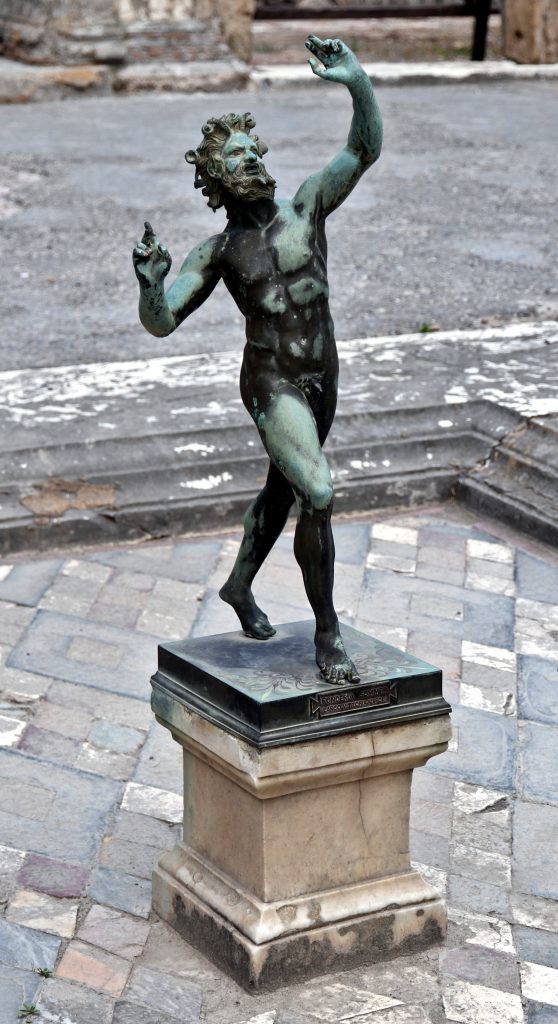
In addition to the remains of a magnificent garden, numerous sculptures and fauns, the inhabitants have preserved a priceless stone mosaic showing the Battle of Issos, fought by the armies of Alexander the Great against Darius III. The original mosaic is housed in the Neapolitan Archaeological Museum.
Thermae
Thermae are otherwise known as public baths, which were used by the ancients. The buildings had a separate section for women and men. Cold, hot and warm water baths were available here.
In the ruins of Pompeii are the remains of three such structures - the Forum Thermae, the Stabian Thermae and the Suburban Thermae. In the baths one can admire, among other things, fragments of historic vaults, a bronze furnace, atlas figures and wall paintings.
Thermopolium
It turns out that the street food trend was already known in the ancient Rome. Thermopolias, one of which has been preserved in excellent condition, were roadside food stands offering inexpensive meals and also hot and cold drinks. They looked like large counters, with openings in which dishes of food stood. Here one could sit for a while, relax and fill one's stomach.
Summary
The monuments that can be found in Pompeii are to the truth remarkable. The described attractions are not all that the ancient ruins have to offer. It is worth at least once in a lifetime to visit this place and move for a moment to the times of the Roman Empire. An additional incentive is the thrill caused by the tragic finale that befell this city. Although looking at the Pompeian ruins unearthed by archaeologists, enjoying the great interest of tourists, one can get the impression that the city has been reborn like a Phoenix from the ashes.
Accommodation
If you want to visit Pompeii and haven't yet booked accommodation, check out the available deals in Naples:
Booking.com
